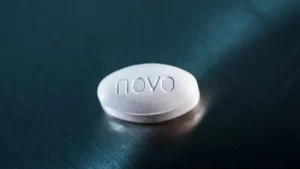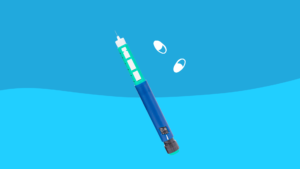Rash From Mounjaro Side Effects: Identifying Common and Serious Risks
HOME | DIABETES EDUCATION | RASH FROM MOUNJARO SIDE EFFECTS: IDENTIFYING COMMON RISKS
If you have a rash from Mounjaro, be aware of common side effects like injection site pain and nausea. Seek guidance from healthcare professionals for proper treatment.
Serious risks include thyroid cancer, pancreatitis, gallbladder issues, and allergic reactions causing swelling, itching, and rash. Prompt medical attention is crucial for these severe reactions.
Monitor skin symptoms closely and seek help for any worrying signs to manage complications effectively.
Understanding these side effects can help you make informed decisions about your health.
Key Takeaways
- Monitor for rash, swelling, itchiness to detect allergic reactions early.
- Seek immediate medical help for severe skin reactions to Mounjaro.
- Understand the importance of identifying and treating allergic responses promptly.
- Ensure proper storage and injection techniques to prevent skin irritations.
- Consult a healthcare provider if a rash appears after Mounjaro for appropriate treatment.
Common Side Effects of Mounjaro
When taking Mounjaro, you may face common side effects like injection site pain and nausea. Nausea is a frequent side effect of Mounjaro, often reported by users. Injection site pain is also commonly experienced during Mounjaro treatment.
Managing these side effects is crucial for the medication to work well for weight loss and diabetes control. Knowing how to ease injection site pain and handle nausea can improve your experience with Mounjaro. Follow the recommended instructions for taking Mounjaro to reduce these typical side effects.
If you have persistent or severe symptoms, seek medical advice to address any concerns and ensure your well-being while on Mounjaro. Stay informed about potential side effects and how to manage them effectively for a smoother treatment experience.
Serious Side Effects of Mounjaro
Serious side effects of Mounjaro, like the boxed warning for thyroid cancer risk, can be very harmful. Using this medication can cause severe digestive issues such as pancreatitis, gallbladder problems, and acute kidney injury. If you have symptoms like upper abdomen pain, loss of appetite, or jaundice, it could be a sign of gallbladder trouble.
In rare cases, allergic reactions to Mounjaro can show up as a skin rash, itching, or swelling in the skin, mouth, tongue, or throat. These reactions need urgent medical attention. If you feel intense abdominal pain, nausea, or vomiting, it could be pancreatitis from Mounjaro.
It’s crucial to act fast if you notice these serious side effects to prevent more problems. Being alert to these risks and getting help quickly can reduce the dangers linked to using Mounjaro. Always put your health first and don’t ignore any troubling symptoms.
Identifying Mounjaros Skin Reactions
To identify Mounjaro’s skin reactions, look for the following signs:
- Rash: Check for any new rashes on your skin after using Mounjaro.
- Swelling: Keep an eye out for swelling under the skin or in sensitive areas like the mouth, tongue, or throat.
- Itchiness and Redness: Notice any unusual itchiness or redness on your skin, which could indicate an allergic reaction to Mounjaro.
Understanding Mounjaros Digestive Effects
To detect Mounjaro’s digestive effects, watch out for symptoms like nausea, diarrhea, and changes in appetite. These signs might point to issues with the medication.
While common side effects include feeling queasy, having loose stools, and appetite changes, more severe problems like gallbladder issues and pancreatitis can occur. Gallbladder problems related to Mounjaro may cause pain in the upper abdomen, reduced appetite, and jaundice.
Pancreatitis, a serious side effect, shows up with symptoms such as vomiting and severe belly pain. It’s important to be alert to these signs and seek medical help promptly if you notice them.
Keeping an eye on how your body reacts to Mounjaro is crucial for spotting and managing any digestive problems that may come up. Stay aware of the potential risks and talk to your doctor if you’re worried about how the medication affects your digestive system.
Allergic Reactions to Mounjaro
If you notice any unusual skin reactions while taking Mounjaro, seek medical help immediately. Allergic reactions to Mounjaro can cause skin rash, itching, and swelling under the skin. Severe reactions may lead to swelling in the mouth, tongue, or throat, which is a serious issue. Immediate medical attention is crucial for severe allergies to Mounjaro to prevent complications.
Mild reactions can show as skin rash or itching, so keep an eye on them. Watch out for any signs of allergic reactions while on Mounjaro and get help if symptoms appear. Itching or rash can be early signs of an allergic reaction, and swelling, especially in critical areas like the mouth and throat, should be monitored closely.
A very serious allergic reaction to this drug is rare. However, get medical help right away if you notice any symptoms of a serious allergic reaction, including: rash, itching/swelling (especially of the face/tongue/throat), severe dizziness, trouble breathing.
https://www.webmd.com/drugs/2/drug-184168/mounjaro-subcutaneous/details
Potential Thyroid Cancer Risk From Mounjaro
Beware of the heightened risk of thyroid cancer associated with Mounjaro, a medication containing tirzepatide. Mounjaro comes with a boxed warning due to an increased chance of thyroid cancer, specifically thyroid C-cell tumors. It is crucial to be cautious of this potential risk, especially if you have a history of medullary thyroid carcinoma (MTC) or Multiple Endocrine Neoplasia syndrome type 2 (MEN 2) in your family. Regular screenings to detect MTC early are advised for individuals using Mounjaro. If you notice symptoms like a neck mass or difficulty breathing, inform your healthcare providers promptly. To stress the importance of monitoring for thyroid cancer risk related to Mounjaro, refer to the table below:
| Thyroid Cancer Risk From Mounjaro | ||
|---|---|---|
| Increased Risk | Thyroid C-cell tumors | Mounjaro Boxed Warning |
| Early Detection | Regular MTC screenings | Prompt Symptoms Reporting |
Managing Mounjaro-Induced Pancreatitis
If you have severe belly pain or ongoing vomiting while on Mounjaro, see a doctor right away. They might stop your Mounjaro to help your pancreas heal.
Regular checks may be needed to monitor and adjust your treatment for pancreatitis caused by Mounjaro. Early action is crucial for managing this condition effectively.
Monitoring for Low Blood Sugar With Mounjaro
After treating Mounjaro-induced pancreatitis, it’s crucial to watch out for signs of low blood sugar. Mounjaro can mix with diabetic drugs, raising the chance of hypoglycemia.
Feeling dizzy, sweaty, confused, or weak could mean your blood sugar is low. Checking your blood sugar regularly is key to preventing hypoglycemia. Severe low blood sugar needs urgent medical care, so monitoring is vital.
If you notice low blood sugar symptoms while on Mounjaro, seek medical help right away. Getting advice from a healthcare provider on handling and treating low blood sugar is essential for your safety. Stay on top of checking your blood sugar levels to use Mounjaro safely and effectively.
Acute Kidney Injury Concerns With Mounjaro
Patients on Mounjaro should watch for symptoms of acute kidney injury, a serious condition linked to severe digestive issues from the medication. Changes in urine color, output, or frequency may signal kidney problems. If you notice concerning signs, consult your healthcare provider immediately.
Regularly monitoring kidney function while on Mounjaro is essential for early issue detection and timely intervention.
Vision Changes Linked to Using Mounjaro
Experiencing blurry vision when using Mounjaro requires immediate consultation with your doctor due to possible eye issues related to the medication. Some people taking Mounjaro have reported blurred vision and eye problems. If you notice changes in your vision, especially blurriness, it’s important to see your doctor right away.
Vision changes can be a significant side effect of Mounjaro that shouldn’t be ignored. To catch any eye issues early, it’s advised to have regular eye exams and monitoring while taking Mounjaro. Your doctor can evaluate the situation, adjust your treatment if needed, or suggest interventions to address vision changes effectively.
Stay vigilant in monitoring your vision health while using Mounjaro to safeguard your overall well-being and address any concerns promptly.
Timeline of Mounjaro Side Effects
When taking Mounjaro, a rash can appear at different times, each indicating specific concerns:
- Immediate rash: Some may develop a rash shortly after taking Mounjaro, signaling an allergic reaction.
- Delayed rash: A rash might show up weeks or months into treatment, requiring attention.
- Persistent or worsening rash: This could point to a severe allergic response needing urgent medical help.
Watch for skin changes while on Mounjaro to catch issues early. Report any troubling signs promptly to your doctor to stay safe.
Contraindications and Warnings for Mounjaro
Don’t take Mounjaro if you or your family have had medullary thyroid carcinoma (MTC) or Multiple Endocrine Neoplasia syndrome type 2 (MEN 2). Allergic reactions to Mounjaro’s ingredients mean you should avoid it.
It’s not for those with type 1 diabetes, under 18, or a history of pancreatitis. Mounjaro can mess with how your body digests oral meds and can cause low blood sugar when taken with insulin or sulfonylureas.
Talk to your doctor about these risks before starting Mounjaro.
Interactions to Consider With Mounjaro
Considerations with Mounjaro interactions include its impact on the absorption of oral medications. Here are key points to remember:
- Combining Mounjaro with insulin or sulfonylureas can increase the risk of low blood sugar.
- Inform your healthcare provider about all medications, supplements, and herbs you’re using before starting Mounjaro.
- Adjustments in timing and dosing of other oral medications may be needed due to Mounjaro’s effect on digestion.
Discuss these interactions with your healthcare provider to manage your treatment effectively and reduce the chance of side effects.
Treating and Preventing Mounjaro Side Effects
Properly rotating injection sites for Mounjaro is crucial to prevent skin reactions and rashes. Storing Mounjaro as instructed helps maintain its effectiveness and lowers the risk of adverse reactions like rashes.
If a rash appears after taking Mounjaro, promptly consult a healthcare provider for proper treatment. Following correct injection techniques and good hygiene practices can reduce the chances of skin irritation or rash formation.
Refrain from scratching the injection site to avoid worsening the rash. Seek medical advice if the rash persists despite preventive measures.
Frequently Asked Questions
What Does an Allergic Reaction to Mounjaro Look Like?
An allergic reaction to Mounjaro can show as a skin rash, itching, or swelling beneath the skin. Severe reactions might cause life-threatening swelling in the mouth, tongue, or throat. If you experience severe symptoms, seek immediate medical assistance.
How Do You Treat Injection Site Reactions With Mounjaro?
To address injection site reactions caused by Mounjaro, apply a cold compress to reduce pain and swelling. Refrain from rubbing the affected area and consider taking over-the-counter pain medications if necessary. If the reactions persist or worsen, seek guidance from your healthcare provider.
What Are the Symptoms of Pancreatitis With Mounjaro?
If you have symptoms like intense belly pain, feeling sick, or throwing up while taking Mounjaro, you should get medical help right away. Stopping the medicine and seeking quick care are crucial for dealing with possible serious dangers.
Can Tirzepatide Cause a Rash?
Yes, tirzepatide can lead to a rash. If you observe red, itchy patches on your skin while using Mounjaro, consult your healthcare provider for evaluation. It is crucial to monitor for allergic reactions, and seek immediate medical assistance for severe rashes or breathing difficulties.



